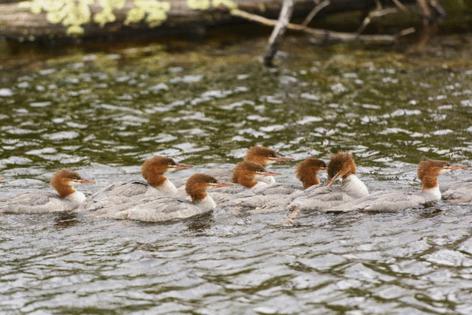Dennis Anderson: Parasites, snails, ducks and government make for itchy battle on Minnesota lake
Published in Outdoors
MINNEAPOLIS — Bill Ness watched two weeks ago as his 5-year-old daughter walked into Pelican Lake in Otter Tail county wearing a full wet suit, with booties.
In less than 10 minutes, the girl’s hands were covered with welts.
The problem: swimmer’s itch.
But not your typical swimmer’s itch, Ness said.
“Comparing what we have to regular swimmer’s itch is like comparing a cold to COVID,” he said.
Ness has been on Pelican Lake since 1982, when his parents bought a cabin that he and his wife have since purchased.
Like thousands of other home and cabin owners on Minnesota lakes, he’s spent a veritable lifetime of summers swimming, tubing and water skiing during the all-too-brief blessings of June, July and August.
But no more.
Now, he, along with other Pelican Lake homeowners, are embroiled in a controversy involving snails, parasites, common mergansers (a type of fish-eating duck), the U.S. Fish and Wildlife Service (FWS) and the Minnesota Department of Natural Resources (DNR).
Playing bit parts in the drama are the bird flu and the former North Dakota governor and current U.S. Interior secretary, Doug Burgum, who has a vacation home on Pelican Lake.
Of these, some Pelican Lake property owners say it’s a toss-up between the parasites and the DNR over who’s causing them the most pain.
Which is saying a lot, because the Pelican Lake variety of swimmer’s itch has sent some people to emergency rooms and made many others — kids as well as adults — suffer for up to two weeks with itchy welts.
“All this time I’ve been on this lake, we haven’t had this problem until a few years ago, when the mergansers started coming here,” Ness said.
Swimmer’s itch shows up in a lot of lakes, including some in Wisconsin, Michigan and Maine, as well as in Minnesota. The problem starts with waterfowl, not only common mergansers, but Canada geese and mallards and probably others.
The birds emit eggs in their feces that ultimately find homes in specific types of snails, where they spawn parasites that can dig under people’s skin.
Parasites that originate from common mergansers — which hunters virtually never pursue — attack people in particularly virulent ways, said Michigan parasitologist Curtis Blankespoor, who holds a doctorate from Cornell University.
Since 1984, Blankespoor and his company, Swimmer’s Itch Solutions, have been permitted by the FWS and the Michigan Department of Natural Resources to capture and transport common mergansers from inland Michigan lakes to various Great Lakes, where snails that host swimmer’s itch parasites don’t exist.
Those translocations are on hold, Blankespoor said, due to concerns about bird flu and the possibility that the transported birds might carry the disease.
Marjorie Mathison Hance is co-chair of Pelican Lake’s swimmer’s itch task force. She’s had a family home on Pelican Lake since 1968 and describes the problem as “traumatic.”
“On the lake we call it ‘merganser measles’ because that’s what this form of swimmer’s itch looks like on people: measles,” Mathison Hance said.
Earlier this year, Pelican Lake homeowners contracted with Blankespoor’s company to help solve their swimmer’s itch problem. On Tuesday, wearing special suits, Blankespoor and a colleague waded into Pelican Lake to collect snails from the lake bottom.
Later, in a makeshift laboratory set up in Mathison Hance’s garage, Blankespoor peered at the snails through microscopes, looking for parasites.
Already they had collected snails from Bay Lake in Crow Wing County, where mergansers are also being blamed for swimmer’s itch. Property owners there also have signed up with Blankespoor’s company.
“Bay Lake is bad, but it’s nothing like what we’ve found in Pelican Lake,” he said. “The 16 percent infection rate of snails in Pelican Lake is worse than we’ve found anywhere in any state, and by a lot.”
Each infected snail releases as many as 5,000 parasites every day, Blankespoor said.
“And new snails are born every year,” he said.
Seeking solution
Blankespoor said that while other waterfowl can be involved in the cycle that produces swimmer’s itch parasites, they are minor players compared to common mergansers.
“Common mergansers are different than other waterfowl in the type and severity of swimmer’s itch they produce, and our research has shown that,” Blankespoor said. “Parasites that originate from the mergansers produce about 45 times more welts than parasites from, for instance, Canada geese.”
Because capturing and moving the Bay and Pelican lakes’ common mergansers wasn’t an option this year due to the bird flu threat, capturing the handful of broods on each lake and injecting them with a commonly used veterinary drug that could interrupt the offending cycle was an option, Blankespoor said.
But the drug hasn’t been cleared for that specific application, and acquiring the necessary permits would take too long.
That left capturing and euthanizing the birds as a final option, and in May, Pelican Lake property owners met in the Twin Cities with Will Meeks, Midwest regional FWS director and Kelly Straka, Minnesota DNR fish and wildlife division director.
The property owners told the wildlife managers their lake association would pay to have the mergansers caught and also pay for a pilot study Blankespoor would conduct over three years to determine whether incidences of swimmer’s itch on Bay and Pelican lakes were reduced, compared to control lakes.
Perhaps the DNR wanted to take part in the study, the property owners said, to help inform future decisions about lake management.
But there was a hitch, the landowners said. The study had to begin by mid-summer, or Aug. 1 at the latest. Otherwise, the cycle that produces the parasites couldn’t be interrupted in time to thwart the same problem next year.
Meeks, of the FWS, had his biologists review the proposal and within weeks he granted a permit similar to one the service awards for the limited taking of cormorants, another protected bird.
I reached out to Straka unsuccessfully, but last Tuesday did talk to Dave Trauba, the recently appointed DNR wildlife section chief.
“To me this is a very big issue,” Trauba said. “It concerns how we want our lakes to look, now and in the future. Don’t we want them to be living lakes, with waterfowl a part of them? It’s complicated, and there are other waterfowl species involved (in swimmer’s itch) besides mergansers. I think we need to do more due diligence to look at all the research that’s out there.”
That’s the same story Pelican Lake property owners have been hearing from Straka since June, Ness said.
Until last Friday morning.
“The DNR denied our permit, and Bay Lake’s also,” Mathison Hance said in a phone call.
Also last Friday, the DNR said removing mergansers to mitigate swimmer’s itch isn’t scientifically justified and it could harm the environment. The agency also worries that if they did it for Pelican and Bay lakes, they might have to do it for others and they don’t want to set a precedent.
“We came here on two different trips, to Bay Lake and to Pelican Lake,” Blankespoor said as he packed up his equipment and prepared to return to Michigan. ”It’s crystal clear to us what the problem is. Next year we’ll try again, and if we can get permission we can trap the mergansers, test them for bird flu, and if they’re negative we can move them to Lake Superior. Or we can inject them (with the aforementioned veterinary drug) and break up the parasite cycle.
“This was the perfect opportunity for everyone, including the DNR, to work together to solve a problem that affects a lot of people.
“We’ll try again. But if I lived on this lake, I’d be very angry.”
©2025 The Minnesota Star Tribune. Visit startribune.com. Distributed by Tribune Content Agency, LLC







Comments